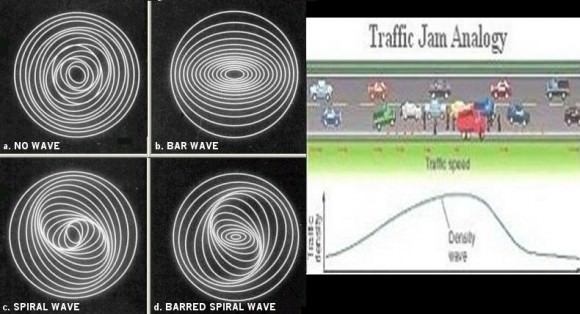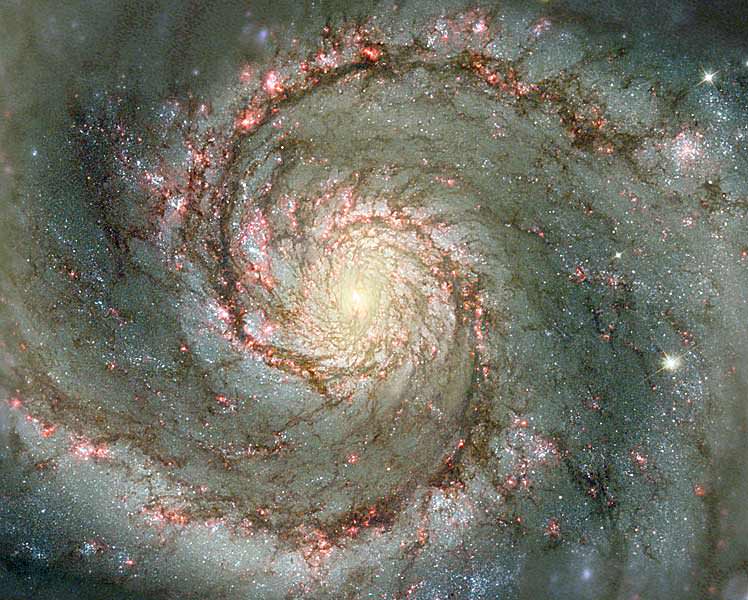[/caption]
A traditional galaxy evolution model has it that you start with spiral galaxies – which might grow in size through digesting smaller dwarf galaxies – but otherwise retain their spiral form relatively undisturbed. It is only when these galaxies collide with another of similar size that you first get an irregular ‘train-wreck’ form, which eventually settles into a featureless elliptical form – full of stars following random orbital paths rather than moving in the same narrow orbital plane that we see in the flattened galactic disk of a spiral galaxy.
The concept of secular galaxy evolution challenges this notion – where ‘secular’ means separate or isolated. Theories of secular evolution propose that galaxies naturally evolve along the Hubble sequence (from spiral to elliptical), without merging or collisions necessarily driving changes in their form.
While it’s clear that galaxies do collide – and then generate many irregular galaxy forms we can observe – it is conceivable that the shape of an isolated spiral galaxy could evolve towards a more amorphously-shaped elliptical galaxy if they possess a mechanism to transfer angular momentum outwards.
The flattened disk shape of standard spiral galaxy results from spin – presumably acquired during its initial formation. Spin will naturally cause an aggregated mass to adopt a disk shape – much as pizza dough spun in the air will form a disk. Conservation of angular momentum requires that the disk shape will be sustained indefinitely unless the galaxy can somehow lose its spin. This might happen through a collision – or otherwise by transferring mass, and hence angular momentum, outwards. This is analogous to spinning skaters who fling their arms outwards to slow their spin.
Density waves may be significant here. The spiral arms commonly visible in galactic disks are not static structures, but rather density waves which cause a temporary bunching together of orbiting stars. These density waves may be the result of orbital resonances generated amongst the individual stars of the disk.

It has been suggested that a density wave represents a collisionless shock which has a damping effect on the spin of the disk. However, since the disk is only braking upon itself, angular momentum still has to be conserved within this isolated system.
A galactic disk has a corotation radius – a point where stars rotate at the same orbital velocity as the density wave (i.e. a perceived spiral arm) rotate. Within this radius, stars move faster than the density wave – while outside the radius, stars move slower than the density wave.
This may account for the spiral shape of the density wave – as well as offering a mechanism for the outward transfer of angular momentum. Within the radius of corotation, stars are giving up angular momentum to the density wave as they push through it – and hence push the wave forward. Outside the radius of corotation, the density wave is dragging through a field of slower moving stars – giving up angular momentum to them as it does so.
The result is that the outer stars are flung further outwards to regions where they could adopt more random orbits – rather than being forced to conform to the mean orbital plane of the galaxy. In this way, a tightly-bound rapidly spinning spiral galaxy could gradually evolve towards a more amorphous elliptical shape.
Further reading: Zhang and Buta. Density-Wave Induced Morphological Transformation of Galaxies along the Hubble Sequence.


The Milky Way is over 12 billion years old and is still a spiral. Could this paper imply that at least some elliptical galaxies may be billions of years older than ours?
Good question. The Milky’s Way evolution has probably not been particularly secular. Maybe a steady diet of dwarf galaxies keeps it looking young (i.e. the addition of more mass spins it up again).
Or maybe this theory needs more work…
I remember when I was a little kid asking whether the Hubble chart had anything to do with how galaxies evolved. The answer was no, but it appears there may be some evolution in there after all.
This is a place to discuss some basic classical mechanics, which everyone should know or be exposed to.
The Poisson equation d*F = -4piG rho m, where d means the vector valued derivative, the m the mass of a small mass and rho the density of matter we can illustrate the motion of matter in a region filled with matter. The Stokes’ law tells us that the volume integral of the scalar d*F bounded by a surface area equals the integration of the vector F on that area. So if that surface area is a sphere or radius r the surface area is 4 pi r^2 and the volume is 4 pi r^3/3. For a more or less constant force F_r (radially directed) on the surface we can write
4 pi r^2 F_r = -4pi G rho m*(4pi r^3/3).
We recognize that the density time the volume is the mass in the region, where if that mass is constant M we get
F_r = -GMm/r^2.
This is the standard Newtonian gravity result. Now for the matter distributed in the region of dynamics with a constant rho this gives a different result
F_r = -(4pi G/3) rho m r.
This is a different force law, it is the Hooke’s law for the motion of a vibrating spring.
Now equate F_r = -mv^2/r, the centripetal acceleration and we get that the velocity as a function of radius is
v = sqrt{(4pi G/3) rho} r,
So the velocity of a particle is faster the further out it reaches. This approximates the velocity profile of stars in a galaxy and is one reason it is thought there is dark matter.
The ellipses in the density wave model or picture of the galaxy are orbits of stars along a two dimensional path predicted by the Hooke’s law potential. However, since the Hooke’s law is only an approximation these ellipses precess. There is a derivable law in classical mechanics that the two force laws which give closed orbits are forces that vary as -1/r and – r. Anything else causes orbits to not close into an ellipse or circle. For this reason these ellipses in a galaxy precess and run into each other. This generates the spiral structure.
As for evolution with older spiral galaxies, I would say that if two spiral galaxies collide the resulting structure is elliptical. This is of course if the dark matter from the two remains more or less in some coalesced state as well. In other words the two DM halos don’t fly off to “infinity” and by their gravitational interactions with the luminous matter (which has energy losses etc) end up forming a single DM halo. If this happens then it is not unreasonable to think the elliptical galaxy will evolve spiral structure. The Milky Way and Andromeda are set to collide in 2 billion years, to form an elliptical galaxy.. It is not unreasonable to think that 2 billion years beyond then there will be a mega spiral galaxy as a result.
LC
logic tells me, that the universe is in some sort of natural balance, which cannot be disturbed by man, only observed, maybe to some extend understood.
1.
galaxies with a distinctly defined spiral shape must have at their center an active black hole, responsible for its motion.
2.
a lesser distinctive spiral shape indicates a much smaller or inactive black hole in its center.
3.
elliptical galaxies do not have a driving motor, i.e. black hole, in its center, maybe never had
My little thesis may be an oversimplification, but holds some general truth.
Re 1 & 2 – this fits conventional thinking. There is a strong correlation between the size of a central SM black hole and the size of the galactic bulge/halo of the galaxy around it. This may be the result of AGN feedback, e.g. see an earlier AWAT http://www.universetoday.com/79562/astronomy-without-a-telescope-black-hole-evolution/
There’s a problem with 3 🙂
There are a lot of active elliptical galaxies with central SM black holes, e.g. M87 – see http://en.wikipedia.org/wiki/Messier_87